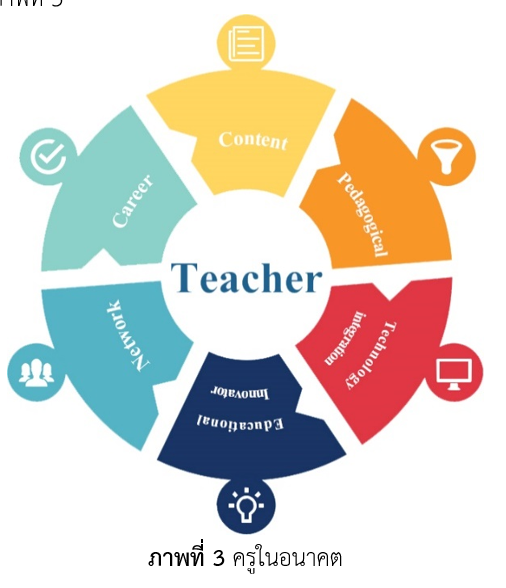การสอนคณิตศาสตร์ในยุคดิจิทัล: วิธีการและเครื่องมือ
Main Article Content
บทคัดย่อ
บทความนี้มีความมุ่งหมายเพื่อเป็นแนวทางให้ครูผู้สอนคณิตศาสตร์สามารถประยุกต์ใช้เครื่องมือดิจิทัลในการจัดการเรียนรู้คณิตศาสตร์ ซึ่งในปัจจุบันเทคโนโลยีมีบทบาทสำคัญในการสร้างสภาพแวดล้อมและสนับสนุนเรียนรู้แบบเชิงรุก (Active learning) โดยครูผู้สอนจะมีบทบาทสำคัญในการออกแบบกิจกรรมการเรียนรู้และเลือกใช้เครื่องมือดิจิทัลเพื่อสนับสนุนให้ผู้เรียนได้มีการเรียนรู้ตลอดเวลาและสามารถแสดงศักยภาพของตนเองออกมาอย่างเต็มที่ โปรแกรมคณิตศาสตร์แบบไดนามิก (Dynamic Mathematics Software: DMS) เป็นเครื่องมือสำคัญที่ช่วยอำนวยความสะดวกในการจัดการเรียนรู้และการบริหารจัดการชั้นเรียนรู้คณิตศาสตร์แบบออนไลน์ ได้แก่ GeoGebra และDesmos เพื่อส่งเสริมให้ผู้เรียนเกิดการเรียนรู้ที่แท้จริง มีการจดจำในการเรียนรู้ที่ยาวนานและมีความฉลาดทางดิจิทัล (Digital Intelligence Quotient : DQ)
Article Details
วารสารวิทยาศาสตร์และวิทยาศาสตร์ศึกษา (JSSE) เป็นผู้ถือลิสิทธิ์บทความทุกบทความที่เผยแพร่ใน JSSE นี้ ทั้งนี้ ผู้เขียนจะต้องส่งแบบโอนลิขสิทธิ์บทความฉบับที่มีรายมือชื่อของผู้เขียนหลักหรือผู้ที่ได้รับมอบอำนาจแทนผู้เขียนทุกนให้กับ JSSE ก่อนที่บทความจะมีการเผยแพร่ผ่านเว็บไซต์ของวารสาร
แบบโอนลิขสิทธิ์บทความ (Copyright Transfer Form)
ทางวารสาร JSSE ได้กำหนดให้มีการกรอกแบบโอนลิขสิทธิ์บทความให้ครบถ้วนและส่งมายังกองบรรณาธิการในข้อมูลเสริม (supplementary data) พร้อมกับนิพนธ์ต้นฉบับ (manuscript) ที่ส่งมาขอรับการตีพิมพ์ ทั้งนี้ ผู้เขียนหลัก (corresponding authors) หรือผู้รับมอบอำนาจ (ในฐานะตัวแทนของผู้เขียนทุกคน) สามารถดำเนินการโอนลิขสิทธิ์บทความแทนผู้เขียนทั้งหมดได้ ซึ่งสามารถอัพโหลดไฟล์บทความต้นฉบับ (Manuscript) และไฟล์แบบโอนลิขสิทธิ์บทความ (Copyright Transfer Form) ในเมนู “Upload Submission” ดังนี้
1. อัพโหลดไฟล์บทความต้นฉบับ (Manuscript) ในเมนูย่อย Article Component > Article Text
2. อัพโหลดไฟล์แบบโอนลิขสิทธิ์บทความ (Copyright Transfer Form) ในเมนูย่อย Article Component > Other
ดาวน์โหลด ไฟล์แบบโอนลิขสิทธิ์บทความ (Copyright Transfer Form)
References
Binbai, S. (2016). Weblog: The Indeniable Digital Age Learning Media for Teachers (in Thai). Phranakhon Rajabhat Research Journal (Humanities and Social Sciences), 11(2), 238-249.
Bonwell, C. C., & Eison, J. A. (1991). Active Learning: Creating Excitement in the Classroom. ASHE-ERIC Higher Education Report, Washington DC: School of Education and Human Development, George Washington University.
Chaemchoy, S. (2015). Technology Leadership: Leading Technology into 21th Century School (in Thai). Journal of Educational Nuresuan University, 17(4), 216-224.
Charnprasert, S. (2014). Active learning: Learning management in the 21st Century. IPST magazine, 42(188), 3-6.
Chosangnin, C. (2019). Digital intelligence. Retrieved 1 April 2020, from IPST Learning Space: https://www.scimath.org/article-technology/item/10611-digital-intelligence
Desmos. (2020). Learn Desmos: Activity builder. Retrieved 1 April 2020, from Desmos: https://learn.desmos.com/create
GeoGebra Team German (2019). GeoGebra groups. Retrieved 1 April 2020, from GeoGebra: https://www.geogebra.org/m/rQrbooeq
Hohenwarter, J., Hohenwarter, M. and Lavicza, Z. (2008). Introducing dynamic mathematics software to teacher: The case of GeoGebra. Journal of Computers in Mathematics and Science Teaching, 28(2), 135-146.
Kleopatra, N. (2020). Secondary education teachers’ perceptions of mobile phone and tablet use in classrooms: benefits, constraints and concerns. Journal of Computers in Education, 7, 257–275.
Kongmanus, k. (2018). Digital learning tools: Ways of digital education era (in Thai). Journal of Education Naresuan University, 20(4), 279-290.
Meesuwan, W. (2014). Cloud Computing for Education (in Thai). Journal of Educational Nuresuan University, 16(1), 149-157.
Nuangchalerm, P. (2020). Teachers in the 21st Century. Journal of Humanities and Social Science Mahasarakham University, 39(1) ,15-24.
Phoodee, W. (2016). The development application process high order thinking by using GeoGebra on the relationship between the two-dimensional to three-dimensional geometry in secondary school student the first grade (in Thai). In Proceedings of the 21st Annual Meeting in Mathematics Annual Pure and Applied Mathematics Conference 2016 (pp. 261-268). Bangkok: Chulalongkorn University.
Rueangrong, P. (2014). Education Technology VS Thai Teacher in 21th Century. Panyapiwat Journal, 5, 195-207.
Songmoungnu, T. (2019). The Active Learning Management for Teachers Under the Office of Basic Education Commission (in Thai). Al-Nur Journal of Graduate School of Fatoni University, 14(27), 63-73.
Srinon, R. (2018). Active Learning Management in the Era of Thailand 4.0 (in Thai). Journal of Educational Administration, Silpakorn University, 9(2), 331-343.
The Institute for the Promotion of Teaching Science and Technology. (2017). A guide to using the curriculum to learn mathematics (revised version B.E. 2560) according to the core curriculum for basic education, 2008. Retrieved 1 April 2020, from SciMath: https://www.scimath.org/ebook-mathematics/item/8380-2560-2551-8380.
Thongma, T. (2018). Mathematics learning resources for mobile learning in digital age (in Thai). Journal of Educations studies, Chulalongkorn University, 46(1), 251-256.

